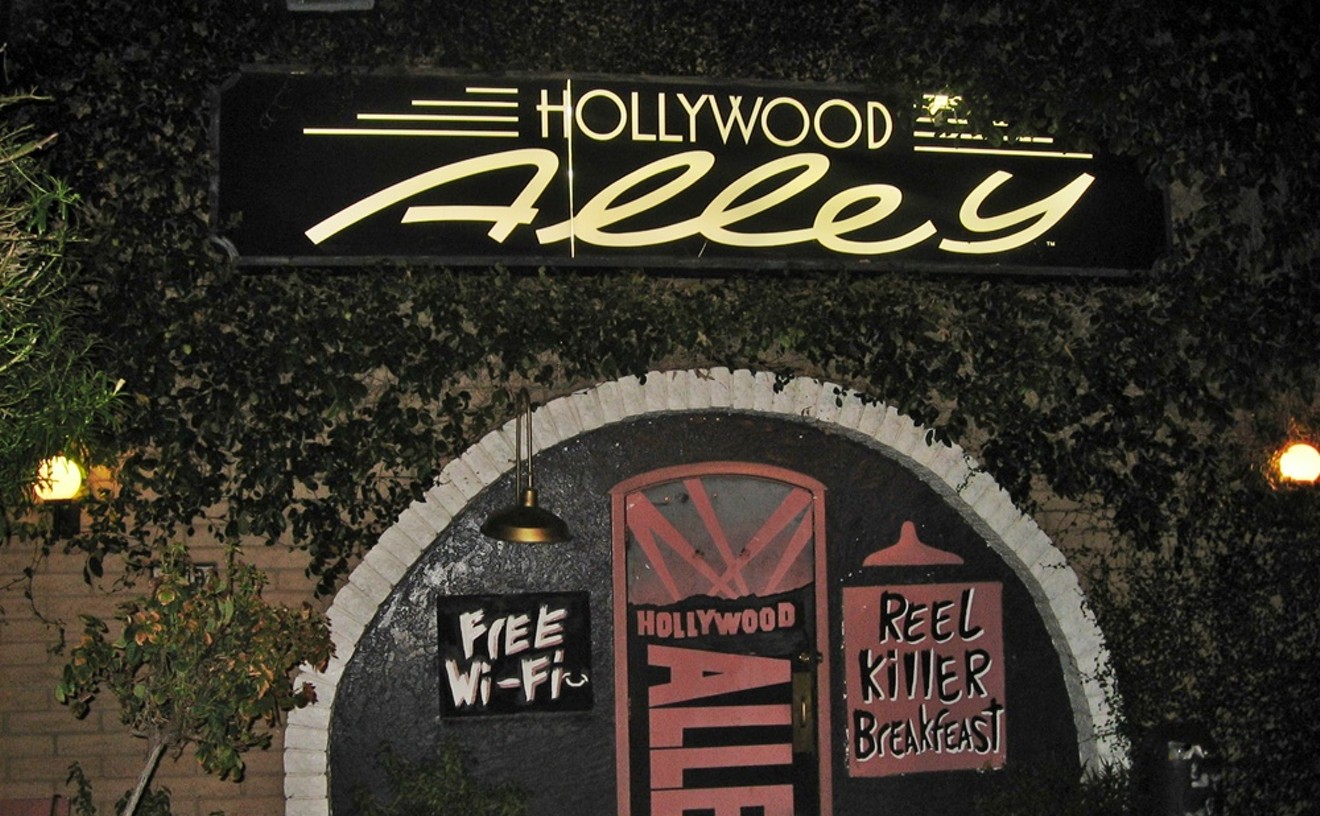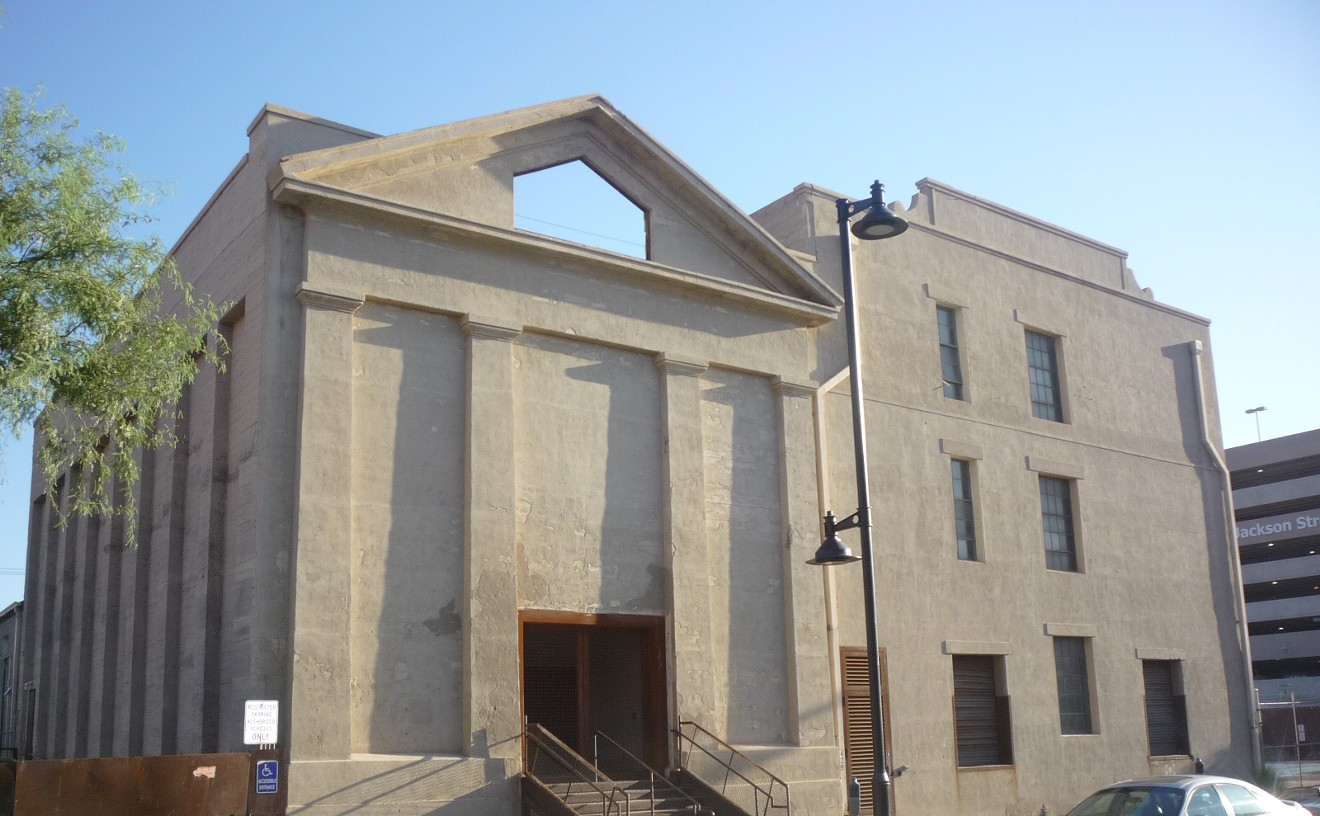When our dining companion slipped into the bathroom at this swanky Scottsdale eatery and stayed a while, we assumed she was sniffing some Bolivian "marching powder" — or getting it on with a hot waiter. But when she returned, she wasn't runny-nosed or chatty; she was rapturous. "Dude, you have got to try the toilet," she breathed. And for once, she was right: These W.C.s really are to die for, from the heated toilet seats to a seat that lifts and rotates its plastic sheath on cue for each new customer, to the incredibly nifty bidets. We guarantee you'll return to your table not only feeling cleaner but positively excited. It's got to be the most fun you can have in a public restroom without breaking the law.
Best Bathroom
Geisha A Go Go
Best Graffiti
Miranda's Custom Cars
Urban beautification takes many forms, and the one we like most is car customizer Luis Miranda's walls at his business, Miranda's Custom Cars, at Central and Grant. The wall sections actually begin on Grant and curve around to First Avenue. On them is some of the finest graf art in the Valley, colossal, colorful pieces featuring jumbo Krylon cans-turned-demons, Transformer-like robots, bandanna-wearing skulls and a hockey-masked Jason, straight out of Friday the 13th.
Those who think graffiti isn't art need only cruise down to Miranda's and inspect this outdoor art show. Kudos to Miranda for allowing talented spray-can wielders to get creative on his property, and to give the lie to the line that all graffiti is urban blight. Why, this art was so impressive that none other than County Attorney Andrew Thomas ripped off some of it for an anti-truancy flier that his office published. Alas, Thomas didn't even bother to contact the artist for permission, much less pay the guy. Still, a piece of the graffiti wall was used in the flier and a fake graf artist posed before it, the implication being that the art was illegal. In fact, it was painted onto a "legal wall." Does that make our county attorney a thief? If we were the artist, we'd make Andy answer that one in court, while we were suing his ass for copyright infringement.
- 706 S. Central Ave., Phoenix, 85004 Map
- 602-712-1783
- www.mirandascustomcars.com
Best Use of Graffiti
1700 Curry

Rob Evans, owner of the storage facility dubbed 1700 Curry, sees in his property a community center for artists and musicians in Tempe. His plan includes building additional stories on top of the current storage buildings, adding a parking lot and even a performance theater for local bands.
Of course, the bigger the dream, the more cold, hard cash is required. To help raise the necessary funds, Evans invited taggers and traditional artists to cover building G on the property with graffiti art. The result was a plethora of painted pieces ranging from a tribute to the Pirates of the Caribbean movie series to a pink mural with stenciled houses in minute detail.
Evans plans to auction off the painted doors of building G to raise money for his artistic utopia. Currently neither a time nor place has been decided upon for the auction, though he has decided to wait until the fall when there are more people in town. Looks as though one person's vandalism is another person's down payment.
- 1700 E. Curry Rd., Tempe, 85281 Map
- 480-966-7021
- www.tempechoicestorage.com/
Best Public Art
Phoenix Forensics Crime Laboratory
David Caruso would eat his heart out if he were to get a gander at the wild, new public art installation in the lobby of the recently opened Phoenix Forensics Crime Laboratory. Pattern Recognition, described by its creators Ralph Helmick and Stuart Schecter as "a surrealistic chandelier that pays homage to the arts of forensic science," dangles from the lobby ceiling like a drug dealer's bad dream.
The mixed-media sculpture, which measures over 17 feet in height and 10 feet in diameter, incorporates hundreds of stock forensic lab equipment items you've seen a hundred times on CSI: Miami — glass beakers, flasks, test tubes, pipettes, blue Petri dishes — all held together by steel rods and laboratory clamps and decorated with over 130 magnifying glasses. Helmick and Schecter's sense of humor is sprinkled liberally throughout with pop culture references to police work in the piece, including patterns representing a bullet hole, a bullet trajectory, and a film reel, together with artist-made molecular models of drugs, fingerprints, DNA helix strands and various and sundry other chemicals and biological substances (we guess there may even be something approximating the structure of anthrax mixed in for good measure). The only thing this piece is missing is a pair of David Caruso's sunglasses.
Best Anticipated Public Art
The as-yet unfinished sculpture by artist Janet Echelman for Civic Space Park
We've been thoroughly entertained by the ballyhoo surrounding the construction of a monumental $2.4 million dollar, wind-driven net sculpture designed by internationally renowned Boston artist Janet Echelman and inspired by the fleeting blossom of Arizona's singular saguaro. First, the sculpture is given the green light and contracted for by the City of Phoenix. Then, nefarious forces want to cancel the contract, supposedly because it won't be finished in time for the opening of Phoenix's light-rail project. After public outcry, the contract is reinstated (actually, it was never rescinded) and we are waiting with bated breath for Echelman's masterpiece to be unveiled with the opening of the light rail, which is woefully set back because of rail defects.
The sculpture's been called a massive sphincter, an upside-down cowpie, a floating jellyfish, an empty thought bubble, and "too arty," whatever that means. Will it actually look like cow poop or a large butthole? Or will it truly be iconic of our fair city and a cultural destination in its own right, as its supporters maintain? We can hardly wait for the finale of this ongoing public art soap opera.
Best Cards
five15 Gallery

We can always count on the folks at the artist-run gallery 515 to come up with the best ideas, and the latest — a series of trading cards featuring the work of the collective's members — didn't disappoint. Each set included a card featuring the work of an artist, along with each member's "stats," suitable for framing or fanning out on the coffee table (as long as you don't have young children or particularly sloppy guests). It's hard to pick a favorite — they're "all stars" — but we are partial to Mary Shindell's cactus, Nathan Feller's creepy bunny-eared lady, and Kenneth Richardson's sausage-loving senior citizens. Mark our words, someday these will go for a fortune on eBay.
- 515 E. Roosevelt St., Phoenix, 85004 Map
- 602-216-0150
- www.515arts.com
Best Buttons
Gregory Sale
From Scottsdale to Glendale, festival-goers wore their hearts on their shirts this year, in the form of Gregory Sale's Love Buttons. The interactive art project pinned thousands of people with the simple-looking white and green buttons. There is nothing simple, however, about the wording, including "RADIATE," "beauti-fully our favorite," and "you under-punctuate m.e."
The buttons provoked both thought and discussion, as participants swapped, added and talked. Lisa Sette included the buttons in the summer group show at her gallery. We can't wait to see what Sale pins his hopes to next.
Best New Art Shindig
Theonix Arts Showcase at Hollywood Alley

There are scene bars, restaurants, and music clubs. Imagine if all three, ahem, scenes could unite into one super-fun scenester extravaganza. Well, thanks to Henri Benard from psychedelic jam band Rocketline, there's one place that folks can hang. Held on the Third Friday of each month, the Theonix Arts Showcase ("Theonix" coming from an amalgamation of Tempe and Phoenix) features artists assaulting live canvasses, local bands such as Princess LadyFriend and Brewed to Perfection rocking out, and Hip Cat the Personal Chef dishing out free hors d'oeuvres. See and be scene.
- 2610 W. Baseline Rd., Mesa, 85202 Map
- 480-820-7117
- www.thehollywoodalley.com
Best New Art Gallery
Eric Firestone Gallery
In February, as we slinked through the galleries on Marshall Way, we came across something particularly spectacular. Walking through the doors, we were suddenly surrounded by dark, gnarling papier-mâché creatures that personified any and all emotional pain we've felt in our lives. This grab-you-by-the-throat-and-make-you-choke show was by a Tucson artist, Michael Cajero. But, much to our surprise, we weren't at one of the area's established galleries.
Instead, we were at the new kid's house: Eric Firestone.
Since then, we've been sure to check out every show and this has become one of our favorite stops. Owner Eric Firestone runs a sister gallery in downtown Tucson and is committed to bringing 20th-century American masters who worked, lived or were connected to the West to his galleries. Modernism, Abstract Expressionism, Pop Art, Minimalism, and any other art movement your grandparents may have lived through explode on the walls on a monthly basis. With such a killer first year, we look forward to 2009.
- 4142 N. Marshall Way, Scottsdale, 85251 Map
- 480-990-1037
- www.ericfirestonegallery.com
Best Stop on Art Detour
The Icehouse

Art Detour celebrated its 20th anniversary this year, so it's only fitting that the coolest part of the annual weekend-long tour of downtown Phoenix studios and galleries was at the old-school art venue known as the Icehouse. There was plenty to see and do at the beyond-spacious former warehouse, which was opened in the early '90s by art maven Helen Hestenes and which was dominated by the edgy and abstract "Post-West" showcase of more than 20 sculptures, installations, and video art pieces, created primarily by ASU students and faculty members.
Our favorite works from the exhibition, which re-interpreted the realities and myths of life in the desert Southwest, had to be Nan Vaughn's water gauge made from The Icehouse's old steel crossbeams and melting ice blocks and Melissa Lewis' imaginative works involving concrete. During the weekend, the Icehouse complex also hosted avant-garde performance artists and dancers, as well as the talented musicians of the Downtown Chamber Series (who busted out with symphonic selections of Dmitri Shostakovich, Igor Stravinsky, and other composers). Outside the venue, artist Ariel Bittner and friends constructed a clunky hut (dubbed the "temple of light") from a colorful collection of hundreds of old glass bottles, encouraging visitors to hang out and relax inside the structure. Don't we feel foolish for throwing away all our empties over the years.
- 429 W. Jackson St., Phoenix, 85003 Map
- 602-257-8929
- www.theicehouseaz.com






